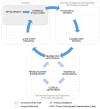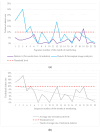Evolution of an Artificial Intelligence-Powered Application for Mammography
- PMID: 40218172
- PMCID: PMC11988740
- DOI: 10.3390/diagnostics15070822
Evolution of an Artificial Intelligence-Powered Application for Mammography
Abstract
Background: The implementation of radiological artificial intelligence (AI) solutions remains challenging due to limitations in existing testing methodologies. This study assesses the efficacy of a comprehensive methodology for performance testing and monitoring of commercial-grade mammographic AI models. Methods: We utilized a combination of retrospective and prospective multicenter approaches to evaluate a neural network based on the Faster R-CNN architecture with a ResNet-50 backbone, trained on a dataset of 3641 mammograms. The methodology encompassed functional and calibration testing, coupled with routine technical and clinical monitoring. Feedback from testers and radiologists was relayed to the developers, who made updates to the AI model. The test dataset comprised 112 medical organizations, representing 10 manufacturers of mammography equipment and encompassing 593,365 studies. The evaluation metrics included the area under the curve (AUC), accuracy, sensitivity, specificity, technical defects, and clinical assessment scores. Results: The results demonstrated significant enhancement in the AI model's performance through collaborative efforts among developers, testers, and radiologists. Notable improvements included functionality, diagnostic accuracy, and technical stability. Specifically, the AUC rose by 24.7% (from 0.73 to 0.91), the accuracy improved by 15.6% (from 0.77 to 0.89), sensitivity grew by 37.1% (from 0.62 to 0.85), and specificity increased by 10.7% (from 0.84 to 0.93). The average proportion of technical defects declined from 9.0% to 1.0%, while the clinical assessment score improved from 63.4 to 72.0. Following 2 years and 9 months of testing, the AI solution was integrated into the compulsory health insurance system. Conclusions: The multi-stage, lifecycle-based testing methodology demonstrated substantial potential in software enhancement and integration into clinical practice. Key elements of this methodology include robust functional and diagnostic requirements, continuous testing and updates, systematic feedback collection from testers and radiologists, and prospective monitoring.
Keywords: artificial intelligence; mammography; radiology; software; software validation.
Conflict of interest statement
Evgeniy Nikitin and Artem Kapninskiy are employees of the company Celsus. They had no role in the design of this study or in the collection, analyses, or interpretation of data. The other authors declare no relationships with any companies whose products or services may be related to the subject matter of the article.
Figures










Similar articles
-
Deep learning performance for detection and classification of microcalcifications on mammography.Eur Radiol Exp. 2023 Nov 7;7(1):69. doi: 10.1186/s41747-023-00384-3. Eur Radiol Exp. 2023. PMID: 37934382 Free PMC article.
-
Methodology for Conducting Post-Marketing Surveillance of Software as a Medical Device Based on Artificial Intelligence Technologies.Sovrem Tekhnologii Med. 2022;14(5):15-23. doi: 10.17691/stm2022.14.5.02. Epub 2022 Sep 29. Sovrem Tekhnologii Med. 2022. PMID: 37181834 Free PMC article.
-
Evaluation of Combined Artificial Intelligence and Radiologist Assessment to Interpret Screening Mammograms.JAMA Netw Open. 2020 Mar 2;3(3):e200265. doi: 10.1001/jamanetworkopen.2020.0265. JAMA Netw Open. 2020. PMID: 32119094 Free PMC article.
-
Artificial intelligence for breast cancer detection and its health technology assessment: A scoping review.Comput Biol Med. 2025 Jan;184:109391. doi: 10.1016/j.compbiomed.2024.109391. Epub 2024 Nov 22. Comput Biol Med. 2025. PMID: 39579663
-
Independent External Validation of Artificial Intelligence Algorithms for Automated Interpretation of Screening Mammography: A Systematic Review.J Am Coll Radiol. 2022 Feb;19(2 Pt A):259-273. doi: 10.1016/j.jacr.2021.11.008. Epub 2022 Jan 20. J Am Coll Radiol. 2022. PMID: 35065909 Free PMC article.
References
-
- Nicosia L., Gnocchi G., Gorini I., Venturini M., Fontana F., Pesapane F., Abiuso I., Bozzini A.C., Pizzamiglio M., Latronico A., et al. History of Mammography: Analysis of Breast Imaging Diagnostic Achievements over the Last Century. Healthcare. 2023;11:1596. doi: 10.3390/healthcare11111596. - DOI - PMC - PubMed
Grants and funding
LinkOut - more resources
Full Text Sources

